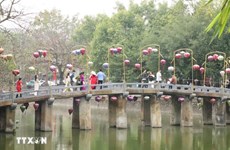Central region seeks responsible tourism
Developing responsible and sustainable tourism in central Vietnam came to the fore at a workshop held in Quang Nam province on September 29.
 Cu Lao Cham (Photo: VNA)
Cu Lao Cham (Photo: VNA)The event was jointly organised by the provincial Department of Culture, Sports and Tourism; the Labour Newspaper; and the United Nations Educational, Scientific and Cultural Organisation (UNESCO).
Present at the workshop were over 120 delegates from international organisations such as UNESCO, the International Labour Organisation (ILO), the Food and Agriculture Organisation (FAO) and the Japan International Cooperation Agency (JICA) along with representatives from the central cities and provinces of Quang Tri, Thua Thien – Hue, Da Nang, Quang Nam, Quang Ngai and Binh Dinh.
A number of reports were presented at the function, underlining the pros and cons of responsible and sustainable tourism development and proposing measures to develop this form of tourism in the central region and Quang Nam in particular.
Director of the provincial Department of Culture, Sports and Tourism Dinh Hai said the local tourism industry has grown strongly in recent years thanks to the support of international organisations and cooperation with other cities and provinces.
The number of tourists to Quang Nam increased to over 3.6 million last year from 1.3 million in 2005, he noted.
Responsible tourism, which is common in western countries, is still in its infancy in Vietnam.
Featured in Vietnam’s tourism strategy for 2020, responsible tourism aims to protect and care for the country’s diverse cultures and environment whilst optimising business processes and ensuring economic sustainability.
Some travel operators are embracing responsible tourism practices, including electricity and water savings, waste treatment, sourcing food locally and providing job opportunities for disadvantaged members of society, including women and ethnic minorities.
The central province of Quang Nam is home to three famous attractions: the World Cultural Heritage Sites of Hoi An Ancient Town, My Son Sanctuary, and the World Biosphere Reserve surrounding the Cham Islands.
Hoi An, recognised by UNESCO as a heritage site in 1999, is an old trading port that dates back to the 15th century. Its architecture and layout reflect the indigenous and foreign influences that melted together to produce the unique character of the town.
My Son Sanctuary is a cluster of abandoned and partially ruined Cham temples. Constructed between the 4th and the 13th century AD, it was once the religious and political capital of the Champa Kingdom.
Meanwhile, the Cham Islands (Cu Lao Cham) constitute a group of eight islets, which form part of the Cu Lao Cham Marine Park, a World Biosphere Reserve also recognised by UNESCO. The islands are well-known for their rich marine ecosystems with more than 300 species of coral, as well as beautiful sand beaches and forested hills.-VNA












